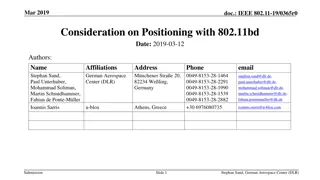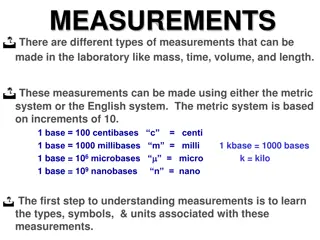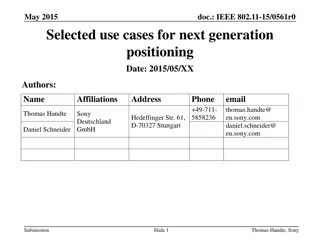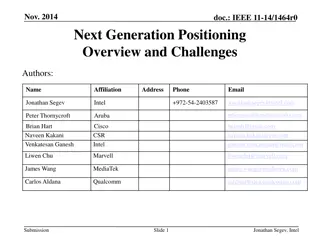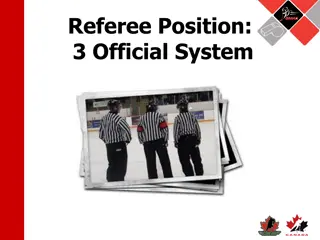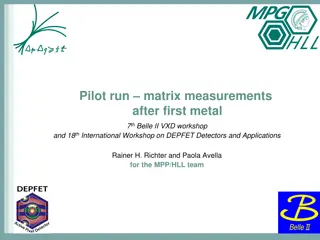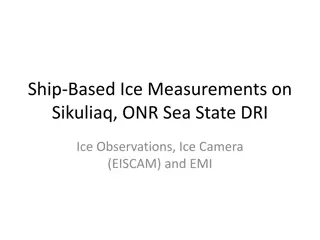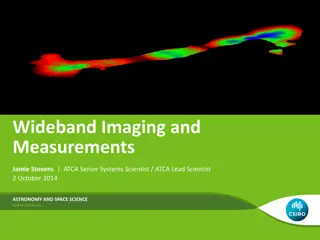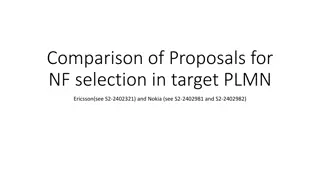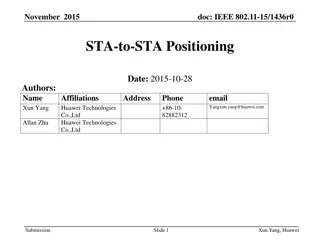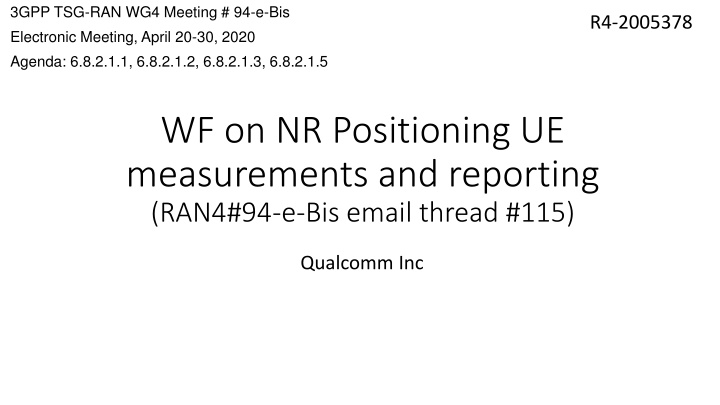
RAN4#94-e-Bis Agenda on NR Positioning Measurements and Reporting
Explore the agenda items discussed at the RAN4#94-e-Bis meeting regarding NR positioning UE measurements and reporting. The topics include parameter mapping tables, PRS RSRP report mapping, UE signaling, and intra/inter-frequency RSTD measurements. Gain insights on the recommendations and agreements made during the electronic meeting.
Download Presentation

Please find below an Image/Link to download the presentation.
The content on the website is provided AS IS for your information and personal use only. It may not be sold, licensed, or shared on other websites without obtaining consent from the author. If you encounter any issues during the download, it is possible that the publisher has removed the file from their server.
You are allowed to download the files provided on this website for personal or commercial use, subject to the condition that they are used lawfully. All files are the property of their respective owners.
The content on the website is provided AS IS for your information and personal use only. It may not be sold, licensed, or shared on other websites without obtaining consent from the author.
E N D
Presentation Transcript
3GPP TSG-RAN WG4 Meeting # 94-e-Bis Electronic Meeting, April 20-30, 2020 Agenda: 6.8.2.1.1, 6.8.2.1.2, 6.8.2.1.3, 6.8.2.1.5 R4-2005378 WF on NR Positioning UE measurements and reporting (RAN4#94-e-Bis email thread #115) Qualcomm Inc
Parameter Parameter k k in report mapping tables in report mapping tables Agreement from GTW session (April 27th 1-3pm UTC): LMF provides a recommended k value (k1). UE selects parameter k (k2) and informs to the LMF. Further discuss the relation between UE selected parameter k2 and network recommended value k1. Further discuss for RSTD and UE Rx-Tx time difference reporting: Relationship between k1 and k2 Range of k1 and k2 in FR1 Agreements on RSTD and UE Rx-Tx time difference report mapping tables captured in LS to RAN2 (R4-2005415)
PRS PRS- -RSRP differential report mapping RSRP differential report mapping Agreement from GTW session (April 27th 1-3pm UTC): [-30,0] dB for DL-AoD and +/- 30 dB for multi-RTT and DL-TDOA Note: values are applicable when PRS RSRP measurements are TDM-ed. Further discuss when PRS RSRP measurements are FDM-ed Further discuss the applicable range of differential PRS-RSRP when PRS-RSRP measurements are FDM-ed Agreements on PRS-RSRP report mapping tables captured in LS to RAN2 (R4-2005415)
N NTA,Offset TA,Offset for Rx for Rx- -Tx time difference reporting Tx time difference reporting Further discuss: Need for UE signaling of NTA,Offset If needed, details on UE signaling of NTA,Offset
Definition of intra Definition of intra- -frequency and inter frequency and inter- -frequency RSTD measurements RSTD measurements frequency Further discuss the definition of intra-frequency and inter-frequency RSTD measurements: Option 1. Intra-frequency RSTD measurement is defined as when the neighbor DL PRS resource and the reference DL PRS resource belong to the same positioning frequency layer. Otherwise, the RSTD measurement is inter-frequency. Option 2. Intra-frequency RSTD measurement is defined when neighbour DL PRS resource and reference DL PRS resource belong to the same positioning frequency layer, and the BW of the positioning frequency layer is within the BW of UE s active DL BWP, and SCS and CP of the positioning frequency layer are the same as those of UE s active DL BWP. Otherwise, the RSTD measurement is inter-frequency. Option 2a. Intra-frequency RSTD measurement is defined when the DL PRS resources to be measured, including reference cell and neighbor cell, have the same center frequency, SCS and CP type as serving cell and the BW of these PRS are all within the active BWP. Otherwise, the RSTD measurement is inter-frequency measurement. Option 3. Intra-frequency RSTD measurement: the center frequency of PRS BW is the center frequency of a serving cell SSB and has the same SCS as that of the serving cell SSB, otherwise it is inter-frequency. MG may be needed for intra- or inter-frequency, depending on whether or not the PRS BW is within the active BWP (NOTE: for RSTD, the above conditions are met for both reference and the other DL links) Option 4. Intra-frequency PRS measurement is defined when the BW of the PRS layer is confined within the UE active BWP. Otherwise, the PRS measurement is inter-frequency.
Measurement period Measurement period Impact of SSB symbols Impact of SSB symbols Further discuss whether PRS-RSTD, PRS-RSRP, and UE Rx-Tx time difference measurement period should be extended to account for dropped PRS occasions being unavailable (e.g., due to overlap with SSB symbols). Details FFS.
Measurement period Measurement period Impact Rx beam sweeping Impact Rx beam sweeping Further discuss whether or how to extend the measurement period to account for Rx beam sweeping in FR2 Option 1. Similar to SSB-based RRM measurement in R15 Option 2. Based on Rx beam sweeping within a PRS occasion over slot repetitions of PRS resources. Details FFS. Other options are not excluded
Measurement period Measurement period Impact of SRS periodicity Impact of SRS periodicity Further discuss whether SRS periodicity impacts UE Rx-Tx time difference measurement period Details FFS
Measurement period Measurement period Basic number of PRS occasions per PRS resource occasions per PRS resource Basic number of PRS Further discuss the basic number of PRS occasions (X) per PRS resource needed to meet the accuracy requirements accounting for fading channel, AGC settling, and muting pattern. Other factors not excluded
Measurement period Measurement period Others Others Measurement period due to HO To be discussed after measurement period without HO is defined Measurement period for more than one frequency layer To be discussed after measurement period for one frequency layer is defined Number of PRS resources for the measurement period definition To be discussed after conclusion of RAN1 UE capability discussions Measurement period with more than one PRS periodicity To be discussed after measurement period with one PRS periodicity is defined
Measurement capability Measurement capability RAN4 to not define the minimum for the number of positioning frequency layers (X1) for positioning requirements RAN1 UE capability for X1 allows values of {1,4} to be signaled with other values FFS. Whether to define the minimum for X2, , X7 to be discussed after the conclusion of RAN1 UE capability signaling Applicability of requirements when exceeding UE processing/buffering to be discussed after the conclusion of RAN1 UE capability signaling
Measurement reporting criteria Measurement reporting criteria Further discuss measurement reporting criteria for PRS-RSTD, PRS- RSRP, and UE Rx-Tx time difference
Scheduling restriction in FR1 Scheduling restriction in FR1 Further discuss scheduling restrictions for PRS symbols in FR1
Measurement gap for PRS measurement Measurement gap for PRS measurement Further discuss when measurement gap is needed for PRS measurement in FR1 and FR2 Further discuss applicability of R15 measurement gap patterns to NR positioning Option 1: at least Rel-15 NR measurement gaps apply for positioning measurements
PRS PRS- -RSTD Side conditions RSTD Side conditions PRS-RSTD side conditions for FR2: Option 1. -3 dB for reference and -10 dB for neighbor cells Option 2. Same as FR1
PRS PRS- -RSRP Side conditions RSRP Side conditions Serving cell: Option 1. -6 dB Option 2. For DL-AoD and Multi-RTT, the side condition for FR1 and FR2 is -3 dB for serving TRP Option 3. Not needed Reference cell: Option 1. For OTDOA (i.e., when configured with RSTD), PRS-RSRP side condition for reference (which may or may not be serving) TRP to be the same as for reference cell for RSTD Option 2. Not needed Option 3. Same as that for the reference cell in PRS-RSTD measurement Neighbor cell: Same as neighbour cell PRS-RSTD
UE Rx UE Rx- -Tx time difference side conditions Tx time difference side conditions Serving cell: Option 1. -6 dB Option 2. Serving cell side condition for UE Rx-Tx: -3 dB, for FR1 and FR2. Option 3. Not needed Reference cell: Not needed.
Accuracy requirements Accuracy requirements Further discuss the number of samples for accuracy requirements for PRS- RSTD and PRS-RSRP Further discuss the applicability of RSTD accuracy requirements under cell change after conclusion of intra-frequency and inter-frequency definition Further discuss the applicability of Rx-Tx time difference accuracy requirements under Cell change TA change
Proximity of SRS and PRS Proximity of SRS and PRS Further discuss the need for proximity condition of SRS and PRS resources in time for UE Rx-Tx time difference measurements Details FFS.
Types of accuracy requirements Types of accuracy requirements Relative and absolute RSRP requirements Option 1. Define only relative accuracy requirements for PRS-RSRP Option 2. Define both absolute and relative accuracy requirements for PRS- RSRP Option 3. Define only absolute accuracy requirements for PRS-RSRP Serving vs. neighbour UE Rx-Tx timing difference Option 1. Define requirements for: Serving cell Neighbor cell Option 2. No separate requirement for serving and neighbour cells
Link Link- -level simulation plan for UE Rx level simulation plan for UE Rx- -Tx time difference Tx time difference Link-level simulations plan: RAN4#95 try to agree on simulation assumptions, RAN4#96 provide first simulation results.
Link Link- -level simulation results level simulation results FFS: The accuracy requirements shall be agnostic to comb pattern (assuming all other configurations are the same) PRS-RSTD, PRS-RSRP, and UE Rx-Tx time difference accuracy requirements will be separately defined for FR1 and FR2.

